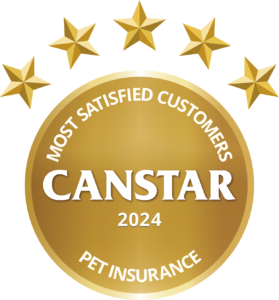Compare pet insurance in New Zealand at Canstar. SPCA Pet Insurance, AA Pet Insurance, Petcover, Pet-n-Sur, PD Insurance and Southern Cross Pet Insurance were compared on Overall Satisfaction, Communication, Comprehensiveness of Cover, Cost, Customer Service and Value For Money.

SPCA Pet Insurance rated No.1 for customer satisfaction.
Our review compares pet insurance providers on customer satisfaction, so you can discover what other Kiwis think about our compared pet insurance providers before you sign up for a policy. Think of it like asking hundreds of your closest friends and family members which pet insurance providers they think deliver the best cover and value for money.
Canstar surveyed 513 Kiwis who currently pay for pet insurance cover and asked them for their feedback on their choice of pet insurance provider.
Respondents rate their satisfaction with their pet insurance providers from zero to ten, where zero is extremely dissatisfied and ten is extremely satisfied. Brand satisfaction was rated by respondents on the following criteria:
The winning pet insurance provider is the one that receives the highest Overall Satisfaction rating once all the scores from the Overall Satisfaction criteria are combined and averaged.
Brands must have received at least 30 responses to be included, so not all brands available in the market have been compared in this survey. The brands rated in this survey are listed below:
Find more information on our Most Satisfied Customer methodology.

PD Insurance offers three levels of pet insurance cover for both cats and dogs. The policies on offer are:
Provides cover for accidents up to $5000 per annum:
Provides cover for accidents and illnesses up to $10,000 per annum. Includes cover for everything in the Accident Plan, plus:
Includes cover for everything in the Classic Plan, plus dental up to $20,000 per annum.
All plans also come with:

Petcover offers three categories of cover for both cats and dogs, within each plan there are three cover levels.
Economy: Provides up to $7000 of annual cover and up to 100% cover on vet fees for pets under the age of four. Other cover includes alternative treatment, third-party liability, death from illness or injury, boarding fees, and loss due to theft or straying.
Catastrophe 1: Up to $5000 annual cover and up to 100% cover on vet fees (up to $400 p.a.) for pets under the age of four. Includes cover for skin treatments, cancer cover, brachycephalic airway obstruction and more.
Catastrophe 2: Provides the same benefits as Catastrophe 1, but with a higher annual limit (up to $10,000) and higher benefit limits in some areas.
Core: $5000 annual limit for veterinary bills and $400 for vet consultations. Provides cover for most illness and accident related issues, including cancer treatment, hip dysplasia, etc.
Vital: Includes cover for everything in the Core Plan, but with a higher annual limit of up to $10,000 and higher benefit limits in certain areas.
Key: Includes cover for everything in the Core and Vital Plans, but with a higher annual limit of up to $15,000 and some higher benefit limits.
Entry: Up to $10,000 annual cover, alternative and complementary treatment, death from illness and injury (under 8 years of age) and a low $150 excess.
Mid-point: Includes the same cover as the entry plan, but with a higher annual limit of $15,000.
Superior: Includes the same cover as the entry plan, but with a higher annual limit of $20,000.
Petcover also offers a range of horse and pony insurance.

Pet-n-Sur offers cover for pets, including: cats, dogs, rabbits and horses. The options of cover vary between each animal. Cat and dog plans range from the comprehensive Platinum plan, to the basic Rhodium plan, as well as surgical options. Rabbit policies are more limited, while equine cover can also include saddlery and tack, horse floats and theft.
Pet-n-Sur’s cover levels for cats and dogs:

Southern Cross Pet Insurance offers two options for cats and dogs: PetCare and AcciPet.
Comprehensive insurance covering sickness and accidental injury up to $15,000 per year, and $25 towards a vaccination or check-up.
Both plans offer a 10-30% co-payment option, to reduce premiums, and if you’re a Southern Cross member, you’ll receive 2.5% off your base pet insurance premium. You can also earn a 2.5% discount for paying by direct debit, and a 5% discount for each additional pet insured. Southern Cross Pet Insurance also offers six weeks free puppy and kitten cover, T&Cs apply.
Not all brands in the market qualify for our ratings (based on minimum survey sample size), but that doesn’t mean they’re not worth considering. Here is another brand to check out before making a purchase decision:

Cove offers three pet insurance policies:
A budget-friendly pet insurance plan that covers your pet for accidental injury only:
Covers both accidents and illnesses, and is designed to be used only for large vet bills, and not everyday expenses:
For if you’d like more certainty about what you’ll need to pay in a year for your pet’s health needs, plus protection from larger unexpected events. Offers same cover as Major plan, except:
Discounts apply for pets under six-months old, taking out multiple policies and choosing to pay annually.

Tower offers three levels of pet insurance cover for cats and dogs:
 About the author of this page
About the author of this pageThis report was written by Canstar’s Editor, Bruce Pitchers. Bruce has three decades’ experience as a journalist and has worked for major media companies in the UK and Australasia, including ACP, Bauer Media Group, Fairfax, Pacific Magazines, News Corp and TVNZ. Prior to Canstar, he worked as a freelancer, including for The Australian Financial Review, the NZ Financial Markets Authority, and for real estate companies on both sides of the Tasman.
Please note that these are a general explanation of the meaning of terms used in relation to pet insurance policy cover. Your insurance provider may use different wording and you should read the terms and conditions of your insurance policy carefully to understand what you are and are not covered for. Refer to the product disclosure statement from your provider.
Accident and Illness: An insurance policy that covers a pet for injury, sickness, illness or disease.
Accidental injury: Physical harm or injury that is caused by a single specific, unpredictable, unusual event that was unintended (an accident) and is not caused by a pre-existing condition.
Accident only: An insurance policy that only covers your pet in the event of an accidental injury.
Age limit: You can usually insure your cat or dog as soon as they are eight weeks old, while some providers will offer insurance from the age of six weeks. Some insurers will only sign up a pet for insurance if it is younger than a certain age. To make your pet eligible for lifelong cover, you should insure your pet before they reach around six years old. Pets above this age may not be eligible for certain types of cover, and may only be eligible for accident-only cover. Make sure you know about any age limits on your policy before you sign up.
Comprehensive: An insurance policy that covers your pet for injury and illness, and also for preventative treatments, routine check-ups, behavioural treatment and other complementary therapies.
Co-payments: Some policies require a co-payment, which means that the insurer pays a listed percentage of the cost of vet fees, usually between 65% and 85%, and you pay the remaining percentage. You are co-paying the expenses. This is sometimes known as co-share. Some policies require that you pay both a co-payment and an excess.
Excess: An amount that you pay instead of the insurer, e.g. “the first” $250 or $500 of a claim. Insurers usually have either a policy with different excess options that you choose between, or separate policies that each have a different excess amount. You can pay a lower premium if you have a higher excess, but you need to be sure that you can afford to pay the excess unexpectedly, if your pet needs emergency treatment.
Exclusions: Anything that is not covered by your policy. When a particular health condition or treatment is listed as being excluded from your policy, the insurer will not cover the expenses for treating that condition, or having that treatment. Common exclusions include behavioural problems, elective procedures, diet and nutrition, grooming, pregnancy, and pre-existing conditions (where your pet showed symptoms before you bought insurance, or during the waiting period).
Extras cover: Another name for comprehensive cover or a policy with routine care benefits. See routine care below.
Inclusions: Anything that is covered by your policy. When a particular health condition or treatment is listed as being included in your policy, the insurer will cover the whole expense or a listed percentage of the expense involved.
Lifelong cover: An insurance policy that covers your pet for as long as they live, even if they grow to a ripe old age. You must renew your policy with the same insurer every year, with no break in cover, to be eligible for lifelong cover, especially for recurring, chronic or ongoing conditions, such as cancer or arthritis.
Limit/benefit limit: Policies have an annual limit on the amount of benefits you can claim. Many policies also have sub-limits for particular types of treatment, e.g. surgery, tick prevention and treatment, or dental. Some policies also have per-incident limits, meaning they will only pay a certain amount per claim, for a particular type of treatment. Most $20,000 policies won’t let you claim $20,000 worth of treatment. Make sure you know how your chosen policy works and whether it suits your pet’s condition, or health requirements.
Optional extras: Treatment options that can be added to your policy if you pay a higher premium.
Pre-existing condition: A condition that existed in any form before you signed up for the insurance policy. This is why insurers have a waiting period for illness, so that if your pet shows symptoms of a condition during the waiting period, they do not have to cover your pet for the costs of treatment. Certain pre-existing conditions will not be covered by insurers at all.
Premium: The amount you pay your insurance provider per year, per month, or per fortnight, for your pet insurance cover. Your premium must be paid on time for your pet to be covered.
Related condition: A condition that is considered to be a pre-existing condition, because it has same the same symptoms or classification as a pre-existing condition your pet has. Related conditions are not covered by your insurance. Unlike pre-existing conditions, related conditions do not have to happen before the commencement date of the policy, or during the waiting period. For example, if your dog has arthritis in its legs and this is a pre-existing condition, and then after the waiting period it develops arthritis in its back, this will be considered a related condition.
Routine care: These are preventative healthcare treatments specified by your insurance provider as procedures they will pay for. Common examples include dental treatment, de-sexing, or emergency boarding in a kennel or cattery. See your product disclosure statement to see whether your policy includes any routine care benefits. These are also known as wellness care, wellbeing care, or extras cover benefits.
Waiting period: Once you purchase an insurance policy for your pet, accidents will usually be covered immediately, but your insurer may impose a waiting period before your pet is covered for certain conditions. For example, a 30-day waiting period may apply for illnesses, and a six-month waiting period may apply for ligament injuries, unless you can provide your insurer with a vet certificate saying your pet does not have any ligament injury. A waiting period will usually apply to hereditary conditions or congenital defects existing at birth.
Wellbeing care: See routine care.
Pet insurance provides peace of mind: 72%
Would consider going into debt to pay for pet’s treatment: 38%
Spend more on pet’s health than own medical bills: 35%
Pay for additional cover, such as dental: 19%
Canstar surveyed 5069 New Zealand consumers across a range of categories to measure and track customer satisfaction, via ISO 26362 accredited research panels managed by Qualtrics. The outcomes reported are the results from respondents who have pet insurance. In this case, 513 New Zealanders. Brands must have received at least 30 responses to be included. Results are comparative and it should be noted that brands receiving three stars have still achieved a satisfaction measure of at least six out of 10. Not all brands available in the market have been compared in this survey. The ratings table is first sorted by star ratings and then by mean overall satisfaction. A rated brand may receive a ‘N/A’ (Not Applicable) rating if it does not receive the minimum number of responses for that criterion.
The past winners from Canstar’s Pet Insurance ratings: